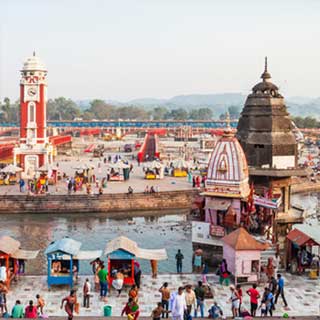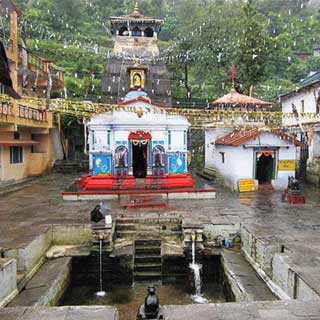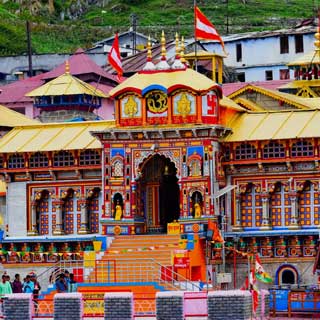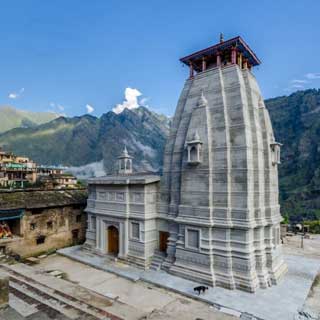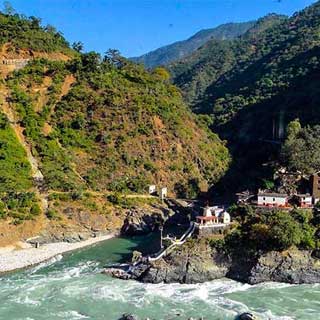Tour Details
DURATION
04 Nights / 05 Days
DESTINATIONS
Delhi – Haridwar – Rishikesh – Rudraprayag – Badrinath – Joshimath – Rishikesh – Haridwar – Delhi
Tour Map
Detailed Itinerary
Day 01: Delhi - Haridwar (230 kms/6-7hrs).Arrival Delhi Airport / Delhi Railway Station, Meet Assist further drive to Haridwar. Transfer to your Hotel. If time permits visit Mansa Devi Temple, Chandi Devi Temple, Daksha Mahadev Temples Others. Also visit Har-ki-Pauri for Ganga Aarti. The Aarti worship of the Ganga after sunset and the floating dia (lamp) is a moving ritual. Back to your hotel, Night halt. Haridwar, lying at the feet of Shivas hills, i.e., Shivaliks, in the Haridwar district of Uttaranchal Pradesh, is a doorway. Suryavanshi prince Bhagirath performed penance here to salvage the souls of his ancestors who had perished due to the curse of sage Kapila. The penance was answered and the river Ganga trickled forth forms Lord Shivas locks and its bountiful water revived the sixty thousand sons of king Sagara. In the traditional of Bhagirath, devout Hindus stand in the sacred waters here, praying for salvation of their departed elder. It is doorway to the sources of the Ganga and the Yamuna, 3000 to 4500 meters up into the snowy ranges of the central Himalayas.
Har ki Pauri: It is also known as Brahma Kund and it is believed to be the place where divine nectar fell from the pitcher. It is the site for the famous Kumbh Mela which is celebrated in 12 years. Large number of devotees comes especially to Haridwar to take a holy dip in the Ganga River. At twilight, when evening aarti has performed the reflection of the golden diyas that keep floating on the river offers an enchanting view of the ghat to the visitors. This sacred Ghat was built by King Vikramaditya in memory of his brother Bhatrihari, who is said to have meditated on the banks of Ganga in Haridwar. Chandi Devi Temple: Situated on the top of the Neel Parvat, Chandi Temple was built in 1929 by Suchat Singh, the King of Kashmir. The temple can be reached after a 3km trek from Chandi Ghat. The main statue of Chandi Devi Temple is said to be established by the Adi Shankaracharya in 8th century. A cable car has also been introduced upto Chandi Devi Temple.
Mansa Devi Temple: Mansa Devi temple is perched on the top of the Bilwa Parwat and it is dedicated to Goddess Mansa Devi. Mansa Devi can be reached either by a ropeway that carries pilgrims to the temple or on foot. A statue of the Goddess here has three mouths and five arms, while the other one has eight arms. The temple affords birds-eye view of Haridwar.
Day 02: Haridwar – Rishikesh (Vehicle Registration) – Devprayag – Rudraprayag
(165kms/5-6hrs)
The morning after Ganga Snan (River Bath), drive to Rishikesh. After vehicle biometric registration formalities (+2hrs process), proceed to Rudraprayag enroute visit Devprayag. Devaprayag is a town and a nagar panchayat in Tehri Garhwal district in the state of Uttarakhand, India, and is one of the Panch Prayag (five confluences) of Alaknanda River where Alaknanda and Bhagirathi rivers meet and take the name Ganga or Ganges River. Arrive at Rudraprayag, Check in Hotel. Rest day at leisure. Overnight stay. Rudraprayag is a town and a municipality in Rudraprayag district in the Indian state of Uttarakhand.
Rudraprayag is one of the Panch Prayag (five confluences) of Alaknanda River, the point of
confluence of rivers Alaknanda and Mandakini. Kedarnath, a Hindu holy town is located 86 km from Rudraprayag. The man-eating leopard of Rudraprayag hunted and written about by Jim Corbett dwelled here.
Day 03: Rudraprayag - Badrinath (160kms/6-7hr)
Early morning, drive straight to Badrinath via Joshimath. Check-in Hotel. Later visit Badrinath
Temple, Pilgrims after having a bath in the Taptkund have the Darshan of Badrivishal. Brahamakapal is significant for Pinddan Shraddh of ancestors (Pitrus). There are other interesting sightseeing spots like Mana, Vyas Gufa, Maatamoorti, Charanpaduka, Bhimkund and the Mukh of the Saraswati River. Just within the three kms of Badrinathjee. At the evening again visit Badrinath Temple for Aarti. Return back to Hotel. Overnight stay.
Badrinath one of the Four Dhams is one of the most celebrated pilgrimage spots of the country
and is situated at an elevation of 3,133 meters, guarded on either side by the two mountain ranges known as Nar Narayan with the towering Neelkanth Peak providing a splendid backdrop. This revered spot was once carpeted with wild berries. Thus the place got the name Badri van meaning forest of berries
Tapt Kund: Natural thermal springs on the bank of the river Alaknanda, where it is customary to bathe before entering the Badrinath temple.
Narad Kund: A recess in the river, near Tapt Kund, forming a pool from where the Badrinath idol was recovered.
Brahama Kapal: A flat platform on the bank of river Alaknanda. Hindus perform propitiating rites for their deceased ancestors.
Sheshnetra: 1.5kms. away is a boulder having an impression of the legendary serpent, better known as the Sheshnags eye.
Charanpaduka: 3kms. away is a beautiful meadow where the footprint of Lord Vishnu is seen on a boulder.
Mata Murty Temple: Devoted to the mother of Sri Badrinathji. Other important temples include
Sesh Netra Temple, Urvashi Temple and Charanpaduka.
Mana Village: Inhabited by an Indo-Mongolian tribe, it is the last Indian village before Tibet.
Vasundhara: As the name suggests, Vasundhara is a magnificent waterfall. This place is 5 km.
from Badrinath out of which 2 km. is motorable upto Mana.
Bhim Pul: On the other side of Mana village, a massive rock forming a natural bridge, lies over the roaring Saraswati river. It presents a spectacular view of water thundering down through the
narrow passage under the rock and is believed to have been placed there by Bhim, the second eldest among the five Pandava brothers.
Vyas Gufa (cave): Near Mana Village, this is a rock cave where Ved Vyas is believed to have
composed the Mahabharata and the pauranic commentaries.
Day 04: Badrinath – Joshimath - Rishikesh (296kms/10-11hr)
Early morning, drive back to Rishikesh enroute to visit Joshimath. Arrive in Rishikesh, Check in Hotel. Overnight stay.
Joshimath is situated on the slopes above the confluence of the rivers Alaknanda and Dhauliganga. Of the four Maths established by Adi Shankaracharya, Joshimath is the winter seat of Badrinath. The idol is brought down to Joshimath and installed in the temple for people to worship. There are many other temples in the township. The most important is the temple of Nir Singh with the idol of Lord Vishnu. The left arm of this deity is getting destroyed with time and the popular belief holds that the day the arm completely withers Badrinath valley will cease to exist and the Gods will
transfer the residence into the neighboring Niti Valley at Bhavishya Badri.
Rishikesh - the place of sages is a celebrated spiritual town on the bank of Ganga and is
surrounded by the Shivalik range of the Himalayas on three sides. It is said that when Raibhya Rishi did hard penances, God appeared by the name of Hrishikesh and this area hence firth came to be known as Rishikesh.
Day 05: Rishikesh – Haridwar – Delhi (250kms/7-8hr)
Morning visit Rishikesh Temples Sight Seeing – Laxman Jhulla, Ram Jhulla, Triveni Ghat, Bharat Mandir. Later drive back to Delhi, transfer to Delhi Airport / Railway Station. Tour Terminate.
Bharat Mandir: The Bharat Mandir is the oldest temple of Rishikesh, situated near the Jhanda
Chowk. Rishi Rabhya did his penance at this holy spot and the place is devoted to Lord Vishnu.
spectacular sacred Shree Yantra is placed at the inner canopy of the temple. Bharat Mandir
celebrates a colorful spring festival called Basant Panchami.
Laxman Jhula: Lakshman Jhula is the main attraction of Rishikesh. It is 450 ft long hanging bridge on the river Ganga which was built in 1939. According to myths and legends Laksman, brother of Lord Rama crossed the Ganga River on a jute rope from this point. The 13-storied temple is located near Lakshman Jhula where the idols of several Gods and Goddesses are kept. The bridge gives a magnificent view of the Ganges, greeting you with the cool breeze from the river.
Ram Jhula: Ram Jhoola connects Swargashram with Shivananda Ashram. Several ashrams are
located near Ram Jhoola. Ram Jhoola is bigger than Laxman Jhula and even more picturesque.
Inclusions:
✓ Pick-up and drop-off from anywhere in Delhi (within city limits).
✓ Chauffeur driven A/C private vehicle for Delhi sightseeing visit.
✓ Professional English-speaking driver.
✓ Fuel charges, parking charges and all taxes.
✓ All transportation using air-conditioned Sedan or SUV or Tempo Traveller.
Exclusions:
⤫ Any kind of entry fees anywhere if not mentioned in including.
⤫ Gratuities (Optional)
⤫ All personal expenses, optional tours and extra meals.




